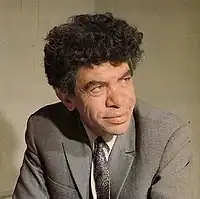Paruyr Sevak
Paruyr Sevak (Armenian: Պարույր Սևակ; January 24, 1924 – June 17, 1971) was an Armenian poet, translator and literary critic. He is considered one of the greatest Armenian poets of the 20th century.[1]
Paruyr Sevak | |
|---|---|
 | |
| Born | Paruyr Ghazaryan January 24, 1924 Chanakhchi, Armenian SSR, Transcaucasian SFSR, Soviet Union |
| Died | June 17, 1971 (aged 47) Yerevan, Armenian SSR, Soviet Union |
| Resting place | Zangakatun, Armenia |
| Nationality | Armenian |
| Period | 1940s-1971 |
| Notable works | We Are Few But We Are Called Armenians, The Unsilenceable Belfry, Man in a Palm, Immortals Command |
| Spouse | Maya Avagyan, Nelli Menagharishvili |
Biography
Sevak was born Paruyr Ghazaryan (Armenian: Պարույր Ղազարյան) in Chanakhchi (now Zangakatun) village, Armenian SSR, Soviet Union to Rafael Soghomonyan and Anahit Soghomonyan on January 24, 1924. Young Paruyr attended the village school. Sevak spent the part of his childhood and adolescence in a location called Navchalu yayla (near Zangakatun) and in his early writings, he signed his writings with ‘Navchalu’ as the location where they were written.[2] Later in 1940 moved to Yerevan to study at the philological faculty of Yerevan State University. He graduated in 1945.[3] The same year he started his postgraduate studies of Armenian literature at the Academy of Sciences Abeghyan Institute of Literature, which lasted until 1948. [3] In 1951 Sevak went to Moscow to study at the Gorky Institute of World Literature.[3] After graduation, he worked there as professor of translation in 1957-59.
Paruyr Ghazaryan adopted the name Paruyr Sevak as his pen name after Western Armenian poet Ruben Sevak.
In 1960 Sevak returned to Yerevan and resumed his prolific and meaningful literary, scientific and public career.[3] He started to work at the Abeghyan Institute of Literature as a scientific researcher.[3] From 1966-1971 Sevak served as secretary on the Board of the Writers Union of Armenia.[3]
In 1967 Sevak became a doctor of philology after his dissertation defense.[3] In 1968 he was elected to the Supreme Council of the Armenian SSR.[3]

Sevak died on June 17, 1971, in a car crash while on a drive back to Yerevan.[3] In previous years, he had voiced his criticism of the corruption of the Soviet establishment and for this, many Armenians believe, he was murdered by the Soviet government.[4] His wife, Nelly Menagharishvili, also died in the car crash. He was buried in the backyard of his home, in Zangakatun, which later became a museum open to everyone.
Literary work
Sevak's poem The Unsilenceable Belfry is dedicated to Armenian composer Komitas Vardapet and to the remembrance of the Armenian genocide.
Publications
- Immortals Command (Անմահները հրամայում են) — 1948
- Uncompromising Intimacy (Անհաշտ մտերմություն) — 1953
- Love's Road (Սիրո ճանապարհ) — 1954
- Let There Be Light (Եղիցի լույս) — 1969
- Your Acquaintances (Ձեր ծանոթները) — 1971
Legacy and memory

One of the mains streets of Yerevan's Kanaker-Zeytun district is named after Sevak.[5] School #123 of Yerevan is named after Paruyr Sevak.[6]
On 2018, the third series of Dram banknotes were printed, featuring Sevak on the 1000 Dram note.
In popular culture
- "Paruyr Sevak" (1984) directed by Levon Mkrtchyan, Armenfilm
References
- Portraits of hope: Armenians in the contemporary world, by Huberta von Voss - 2007 - p. 116
- Ghulyan, Husik (2020-12-01). "Conceiving homogenous state-space for the nation: the nationalist discourse on autochthony and the politics of place-naming in Armenia". Central Asian Survey. 40 (2): 257–281. doi:10.1080/02634937.2020.1843405. ISSN 0263-4937. S2CID 229436454.
- Կենսագրություն (in Armenian). ParuyrSevak.com. Retrieved August 3, 2012.
- Malkasian, Mark (1996). Gha-ra-bagh!: The Emergence of the National Democratic Movement in Armenia. Detroit: Wayne State University Press. p. 215. ISBN 9780814326046.
- "Sevak St, Yerevan, Armenia". Google Maps. Retrieved August 2, 2012.
- "YEREVAN BASIC SCHOOL №123 NAMED AFTER PARUYR SEVAK". Spyur: Company Register of Armenia. Retrieved August 2, 2012.